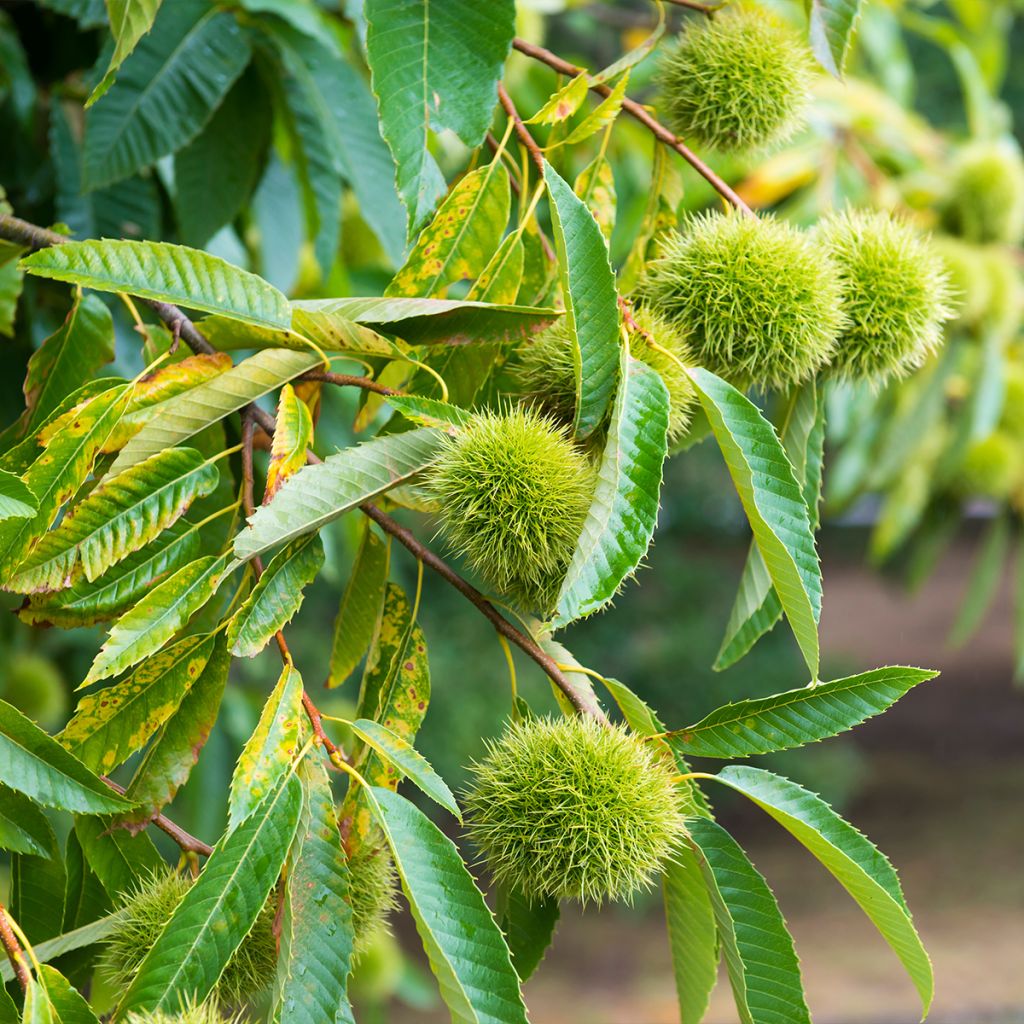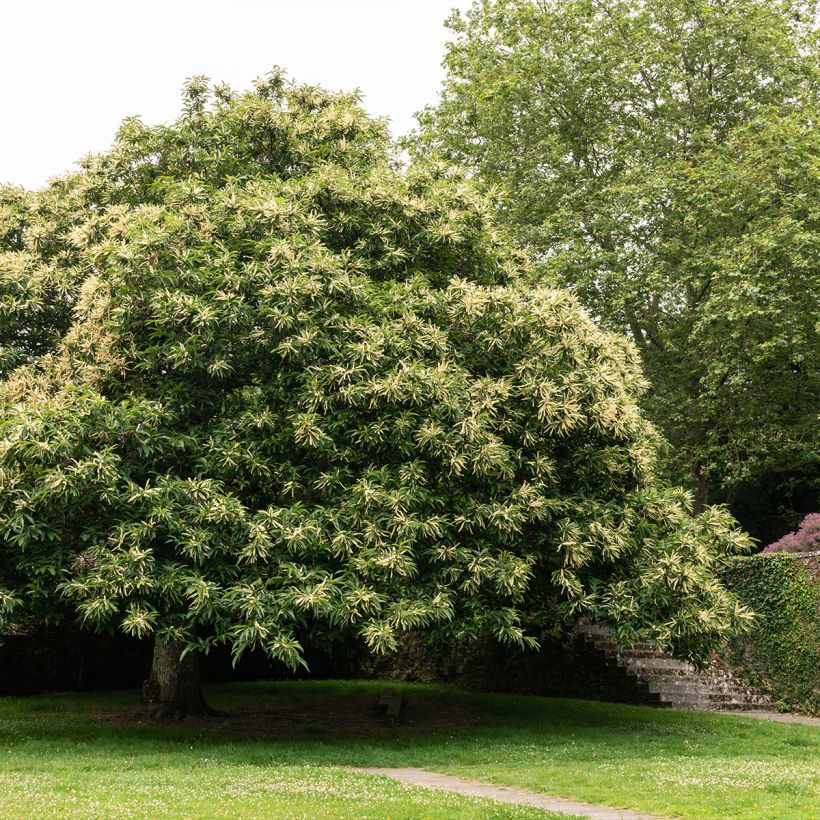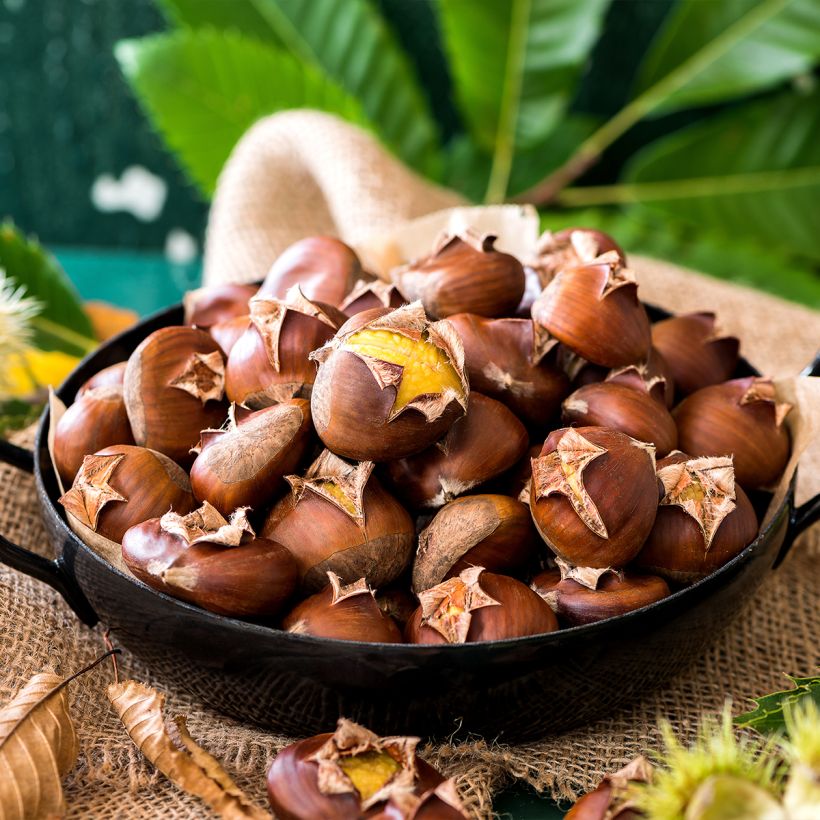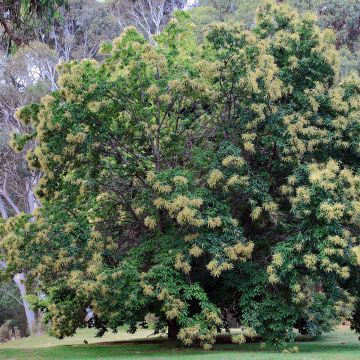

Chestnut Marlhac - Castanea sativa


Chestnut Marlhac - Castanea sativa


Chestnut Marlhac - Castanea sativa


Chestnut Marlhac - Castanea sativa
Chestnut Marlhac - Castanea sativa
Castanea sativa Marthac
Sweet Chestnut, Spanish Chestnut
This plant carries a 6 months recovery warranty
More information
We guarantee the quality of our plants for a full growing cycle, and will replace at our expense any plant that fails to recover under normal climatic and planting conditions.
From €5.90 for pickup delivery and €6.90 for home delivery
Express home delivery from €8.90.
Description
The 'Marlhac' Chestnut tree, a majestic tall tree, is a creation of INRA. It comes from the cross-breeding between a European chestnut tree ('Laguépie' Chestnut) and a Japanese chestnut tree (Castanea crenata), which gives it good vigour, abundant production of large fruits, and excellent disease resistance. Its flowering is highly appreciated by apiarists as it produces a highly sought-after honey that does not crystallise. In September, this variety produces triangular-shaped chestnuts with a mahogany colour, sweet flesh that peels easily, and good storage capacity. The harvest of chestnuts is a real pleasure for various culinary uses. The 'Marlhac' Chestnut tree, sensitive to cold, will particularly thrive in the southwest of the continent, in acidic and well-drained soil.
Originally from the Caucasus and introduced to Western Europe by the Romans, the Chestnut tree (Castanea sativa) is very common in the southern and southwestern regions, as well as in Corsica. It can also be found quite regularly on the atlantic coast, as it avoids geographical areas with limestone or clay soils. The chestnut tree belongs to the Fagaceae family. It is a majestic tree that can reach a height of 20 to 30 metres (66 to 98 feet) and can live for more than 1000 years. The lanceolate and toothed leaves, 15 to 25 cm (6 to 10in) long, are dark green and shiny on the upper side and matte green on the underside, revealing prominent veins. The foliage takes on autumnal hues ranging from yellow to reddish-brown before falling. The Chestnut tree is a monoecious tree, flowering occurs in June-July with female flowers grouped in cups and male flowers grouped in long cylindrical yellow catkins. The flowers, which are very rich in nectar, are pollinated by the wind and insects, especially bees that gather nectar from them. The fruits, which are inserted in pairs or threes in a spiky bur, reach maturity in September-October. A Chestnut tree produces 70 to 100 kg of chestnuts per year. When ripe, the fruits fall to the ground, making them easy to harvest. It is advisable to wear protective gloves when removing the chestnuts from their bur. The chestnut tree belongs to the category of shell fruits like almonds, hazelnuts, walnuts, and pecans.
The 'Marlhac' Chestnut tree is a semi-early variety and takes some time to bear fruit (4 to 5 years). In September, it produces large-sized (20 to 25 grams), triangular-shaped chestnuts with a mahogany colour, floury and sweet flesh, and a woody flavour. These chestnuts store quite well and are very easy to peel. This variety is resistant to leaf rust, ink disease (Phytophthora root rot), bark canker, and other diseases.
Chestnuts are considered a starchy fruit. They are high in calories, rich in carbohydrates, vitamin B, and dietary fibre, and they contain gluten-free proteins. For a cozy pleasure by the fire, they can be roasted in a perforated pan. Cooked, they can be enjoyed plain, in soups, or pureed. In sweet versions, they can be used to make chestnut cream or candied chestnuts. As chestnut jam, they are perfect for spreading on a crepe or sweetening yogurt. Blanched, candied, or braised, the well-peeled chestnut accompanies savory dishes nicely.
The 'Marlhac' Castanea sativa is a majestic tree, so it is important to choose a suitable space for it. To improve fruiting, this tree needs to be in close proximity to other chestnut trees for better cross-pollination.
Report an error about the product description
Chestnut Marlhac - Castanea sativa in pictures




Plant habit
Fruit
Flowering
Foliage
Botanical data
Castanea
sativa
Marthac
Fagaceae
Sweet Chestnut, Spanish Chestnut
Cultivar or hybrid
Other Chestnut trees
Planting and care
Plant the Castanea sativa 'Marlhac' in a deep, well-draining soil with a tendency to be acidic, definitely not chalky. The planting hole should be much wider than the plant you are planting. Choose the location carefully, as the chestnut tree dislikes being transplanted. Do not bury the base of the trunk. Water it generously at the beginning to promote establishment. Pruning should be light, but to allow for passage underneath when it is fully grown, remove the lower branches gradually. Avoid cutting branches that are too thick. This variety, although hardy, fears late spring frosts that can damage the buds. It is better suited to southern regions, which are less exposed to this phenomenon.
Planting period
Intended location
Care
This item has not been reviewed yet - be the first to leave a review about it.
Haven't found what you were looking for?
Hardiness is the lowest winter temperature a plant can endure without suffering serious damage or even dying. However, hardiness is affected by location (a sheltered area, such as a patio), protection (winter cover) and soil type (hardiness is improved by well-drained soil).

Photo Sharing Terms & Conditions
In order to encourage gardeners to interact and share their experiences, Promesse de fleurs offers various media enabling content to be uploaded onto its Site - in particular via the ‘Photo sharing’ module.
The User agrees to refrain from:
- Posting any content that is illegal, prejudicial, insulting, racist, inciteful to hatred, revisionist, contrary to public decency, that infringes on privacy or on the privacy rights of third parties, in particular the publicity rights of persons and goods, intellectual property rights, or the right to privacy.
- Submitting content on behalf of a third party;
- Impersonate the identity of a third party and/or publish any personal information about a third party;
In general, the User undertakes to refrain from any unethical behaviour.
All Content (in particular text, comments, files, images, photos, videos, creative works, etc.), which may be subject to property or intellectual property rights, image or other private rights, shall remain the property of the User, subject to the limited rights granted by the terms of the licence granted by Promesse de fleurs as stated below. Users are at liberty to publish or not to publish such Content on the Site, notably via the ‘Photo Sharing’ facility, and accept that this Content shall be made public and freely accessible, notably on the Internet.
Users further acknowledge, undertake to have ,and guarantee that they hold all necessary rights and permissions to publish such material on the Site, in particular with regard to the legislation in force pertaining to any privacy, property, intellectual property, image, or contractual rights, or rights of any other nature. By publishing such Content on the Site, Users acknowledge accepting full liability as publishers of the Content within the meaning of the law, and grant Promesse de fleurs, free of charge, an inclusive, worldwide licence for the said Content for the entire duration of its publication, including all reproduction, representation, up/downloading, displaying, performing, transmission, and storage rights.
Users also grant permission for their name to be linked to the Content and accept that this link may not always be made available.
By engaging in posting material, Users consent to their Content becoming automatically accessible on the Internet, in particular on other sites and/or blogs and/or web pages of the Promesse de fleurs site, including in particular social pages and the Promesse de fleurs catalogue.
Users may secure the removal of entrusted content free of charge by issuing a simple request via our contact form.
The flowering period indicated on our website applies to countries and regions located in USDA zone 8 (France, the United Kingdom, Ireland, the Netherlands, etc.)
It will vary according to where you live:
- In zones 9 to 10 (Italy, Spain, Greece, etc.), flowering will occur about 2 to 4 weeks earlier.
- In zones 6 to 7 (Germany, Poland, Slovenia, and lower mountainous regions), flowering will be delayed by 2 to 3 weeks.
- In zone 5 (Central Europe, Scandinavia), blooming will be delayed by 3 to 5 weeks.
In temperate climates, pruning of spring-flowering shrubs (forsythia, spireas, etc.) should be done just after flowering.
Pruning of summer-flowering shrubs (Indian Lilac, Perovskia, etc.) can be done in winter or spring.
In cold regions as well as with frost-sensitive plants, avoid pruning too early when severe frosts may still occur.
The planting period indicated on our website applies to countries and regions located in USDA zone 8 (France, United Kingdom, Ireland, Netherlands).
It will vary according to where you live:
- In Mediterranean zones (Marseille, Madrid, Milan, etc.), autumn and winter are the best planting periods.
- In continental zones (Strasbourg, Munich, Vienna, etc.), delay planting by 2 to 3 weeks in spring and bring it forward by 2 to 4 weeks in autumn.
- In mountainous regions (the Alps, Pyrenees, Carpathians, etc.), it is best to plant in late spring (May-June) or late summer (August-September).
The harvesting period indicated on our website applies to countries and regions in USDA zone 8 (France, England, Ireland, the Netherlands).
In colder areas (Scandinavia, Poland, Austria...) fruit and vegetable harvests are likely to be delayed by 3-4 weeks.
In warmer areas (Italy, Spain, Greece, etc.), harvesting will probably take place earlier, depending on weather conditions.
The sowing periods indicated on our website apply to countries and regions within USDA Zone 8 (France, UK, Ireland, Netherlands).
In colder areas (Scandinavia, Poland, Austria...), delay any outdoor sowing by 3-4 weeks, or sow under glass.
In warmer climes (Italy, Spain, Greece, etc.), bring outdoor sowing forward by a few weeks.



































